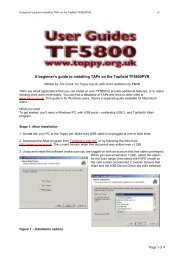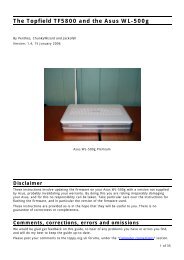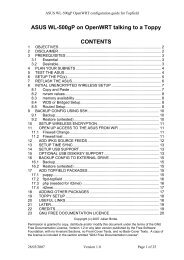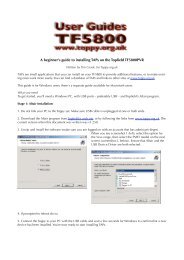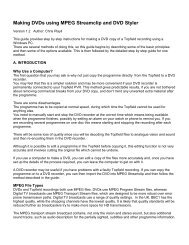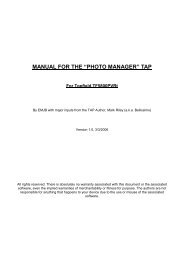Download - Toppy.org.uk
Download - Toppy.org.uk
Download - Toppy.org.uk
You also want an ePaper? Increase the reach of your titles
YUMPU automatically turns print PDFs into web optimized ePapers that Google loves.
VR Series Microprocessors<br />
NEC Electronics Inc.<br />
Low-Latency Instructions<br />
The MIPS IV instruction set supports four multiply-addsubtract<br />
instructions:<br />
• Multiply-Add (MADD)<br />
• Multiply-Subtract (MSUB)<br />
• Negative Multiply-Add (NMADD)<br />
• Negative Multiply-Subtract (NMSUB)<br />
Two separate floating-point computations can be performed<br />
with one instruction.<br />
Large On-Chip Primary Caches<br />
The VR5000 contains separate 32 KB data and instruction<br />
caches. Each cache has a 32-byte fixed line size and is twoway<br />
set associative, which helps to increase the hit rate over a<br />
direct-mapped implementation. Cache lines may be classified<br />
as write-through or write-back on a per-page basis.<br />
Both caches are virtually indexed and physically tagged. A<br />
virtually indexed cache allows the cache access to begin as<br />
soon as the virtual address is generated, as opposed to waiting<br />
for the virtual-to-physical translation. The cache is accessed at<br />
the same time as the address translation is performed.<br />
Having large primary caches allows more of the application to<br />
be executed on chip, reducing accesses to slower secondary<br />
caches and main memory. This in turn reduces bus utilization<br />
and allows the application to run faster, since fewer off-chip<br />
accesses are required.<br />
Contact List<br />
USA<br />
VR Series RISC Products Group<br />
NEC Electronics Inc.<br />
2880 Scott Boulevard<br />
Santa Clara, CA 95050<br />
Tel: (800) 366-9782 or (408) 588-6000<br />
E-mail: vrsupport@el.nec.com<br />
Japan<br />
NEC Corporation<br />
1753 Shimonumabe, Nakahara-Ku<br />
Kawasaki, Kanagawa 211, Japan<br />
Tel: +81-44-435-1485<br />
Secondary Cache Support<br />
Large applications often use a secondary cache to reduce the<br />
number of accesses to slower main memory. The VR5000<br />
contains a dedicated secondary cache interface with a<br />
complete set of signals (such as data enable, chip enable,<br />
output enable, address match, cache valid, line index, and<br />
word index) that provides an efficient interface with the<br />
processor, a secondary cache configured as 512 KB or 1 MB<br />
or 2 MB, and secondary cache tag RAM.<br />
The secondary cache interface supports multiple cache sizes<br />
and the write-through data transfer protocol. Data transfers to<br />
the secondary cache share the 64-bit system bus. Uncached<br />
bus cycles are not evaluated by the secondary cache control<br />
logic as they travel to the external agent. Uncached operations<br />
such as video screen updates can be passed directly to the<br />
system logic responsible for routing the data to the screen<br />
without any delays from the secondary cache logic.<br />
17



